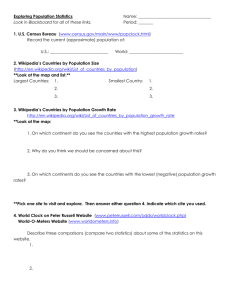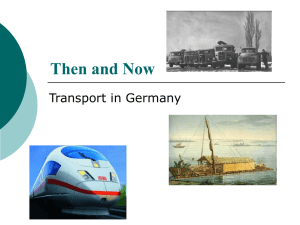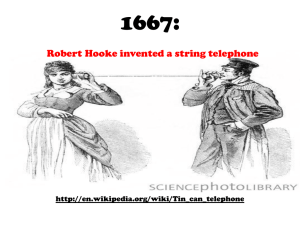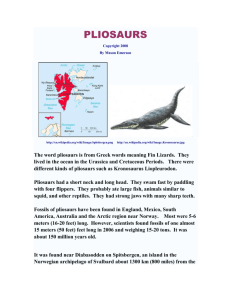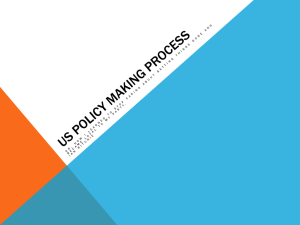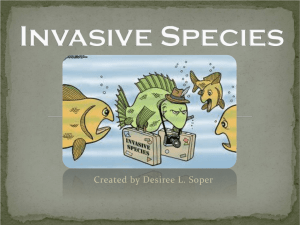File
advertisement
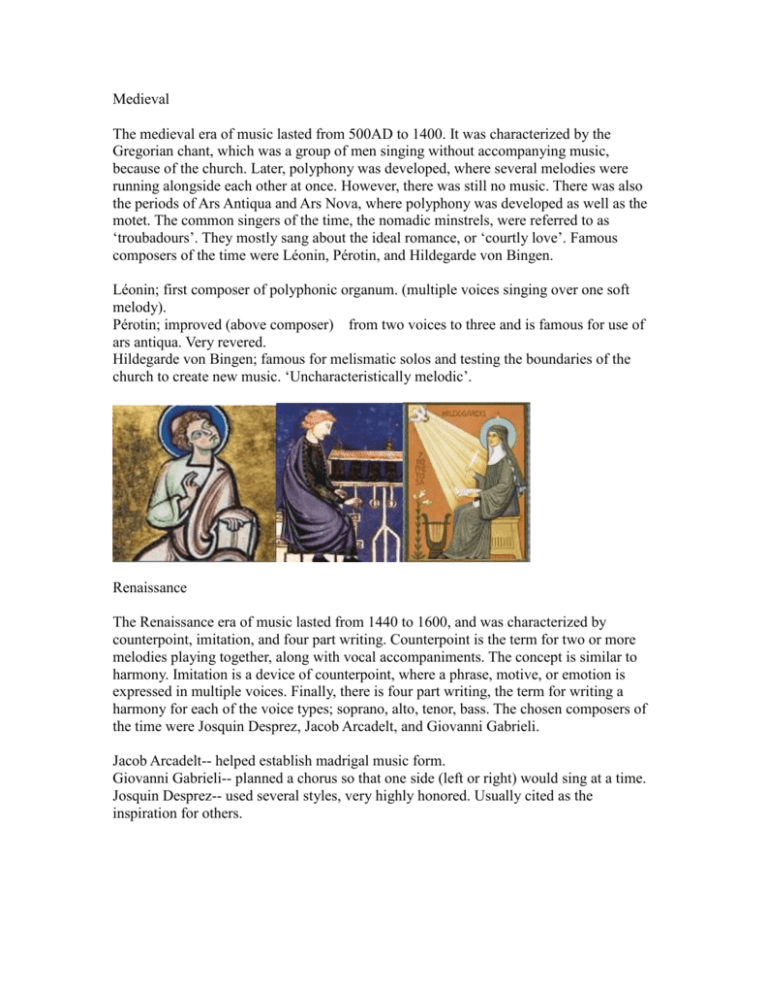
Medieval The medieval era of music lasted from 500AD to 1400. It was characterized by the Gregorian chant, which was a group of men singing without accompanying music, because of the church. Later, polyphony was developed, where several melodies were running alongside each other at once. However, there was still no music. There was also the periods of Ars Antiqua and Ars Nova, where polyphony was developed as well as the motet. The common singers of the time, the nomadic minstrels, were referred to as ‘troubadours’. They mostly sang about the ideal romance, or ‘courtly love’. Famous composers of the time were Léonin, Pérotin, and Hildegarde von Bingen. Léonin; first composer of polyphonic organum. (multiple voices singing over one soft melody). Pérotin; improved (above composer) from two voices to three and is famous for use of ars antiqua. Very revered. Hildegarde von Bingen; famous for melismatic solos and testing the boundaries of the church to create new music. ‘Uncharacteristically melodic’. Renaissance The Renaissance era of music lasted from 1440 to 1600, and was characterized by counterpoint, imitation, and four part writing. Counterpoint is the term for two or more melodies playing together, along with vocal accompaniments. The concept is similar to harmony. Imitation is a device of counterpoint, where a phrase, motive, or emotion is expressed in multiple voices. Finally, there is four part writing, the term for writing a harmony for each of the voice types; soprano, alto, tenor, bass. The chosen composers of the time were Josquin Desprez, Jacob Arcadelt, and Giovanni Gabrieli. Jacob Arcadelt-- helped establish madrigal music form. Giovanni Gabrieli-- planned a chorus so that one side (left or right) would sing at a time. Josquin Desprez-- used several styles, very highly honored. Usually cited as the inspiration for others. Baroque The Baroque period lasted from 1600AD to 1750AD, and gave rise to several new styles and ways of creating music, such as the opera, sonata, concerto and oratorio. There was also the invention of the harpsichord. The Baroque period is part of the Common Practice Period, the name for the three stages of ‘classical’ music. It is generally identified by its lack of parallel fifths and its used of proper chords. Alessandro Scarletti-- started to change the genre, standardized forms, embellished arias, minimized recitatives, created a sub-genre of opera seria. Giovanni Battista Pergolesi-- responsible for the subgenre of comic opera George Frideric Handel-- tinkered with the English oratorio after moving there, added a chorus. Classical The era that most refer to as ‘classical’ is generally the Common Practice Period, but in other terms, it refers to the period lasting from 1750 to 1810. During this period, counterpoint was not used in place of homophony, and orchestral music grew increasingly popular. Homophony is a type of musical texture where one dominant melody is supported. Important composers of this time period were Franz Joseph Haydn, Wolfgang Amadeus Mozart, and Christoph Willibald Gluck. Franz Joseph Haydn-- properly organized symphonies, had a particular style. Credited with inspiring many of the composers that followed after him. Wolfgang Amadeus Mozart-- similar to Haydn, but ‘more flamboyant’ with more notes. Christoph Willibald Gluck-- softened recitative and aria’s contrast, wove in underlying melodies (themes) and passages (orchestral) as the recitatives melded with the arias. Also wrote in a style similar to modern film scores, where he had the text first and the melody second. Romantic Romantic music, lasting from 1810 to 1890, is the final part of the Common Practice Period. It is identified by its use of program music and nationalism. Program music is used to be more descriptive and induce imagery, and is closely related to literature and art, prompting many tales to be translated into operas or ballets. Program music is also identified by its motifs, its themes changing, or using a specific instrument as a sound effect. Harmony, dynamics, tempo, and key are all also quite important. Nationalism is the features of a nation being identified through the music, making it easy to pinpoint the country of origin of the style of music. Important composers of the time were Ludwig van Beethoven, Wilhelm Richard Wagner, and Frederic Chopin. Ludwig van Beethoven-- used modulation, where themes were developed. Also, improved the style of juxtaposing keys from Haydn. Wilhelm Richard Wagner-- forefront of extreme chromaticism, and ‘shifting tonal structures’. Frederic Chopin-- one of the first composers to use nationalism in his work. Modern ‘Modern’ music refers to the period lasting from 1890 to 1950. It created and used chromaticism, impressionism, neoclassism, and serialism. Chromaticism is ‘interspersing the primary diatonic tones and pitches with other pitches of the chromatic scale’ according to the Wikipedia article on the subject, while impressionism is a series of harmonic textures, organized so that there is no sense of forward movement, or of ‘tension and release’. Neoclassism is the use of emotional restraint, simple materials, structures, and finally textures. Finally, serialism is one pattern, theme, or even note that repeats over and over. Important composers from this time period were Igor Stravinsky, Achille Claude Debussy, and Sergei Prokofiev. Igor Stravinsky-- his ‘rite of spring’ confronted the ‘aesthetics of impressionism’, helped redefine music. Achille Claude Debussy-- purposefully made his music evoke vague feelings, used parallel chords to keep things from being clearly defined. Sergei Prokofiev-- style considered unique by teachers, ended up making music considered revolutionary for the Bolsheviks, later told to stop because his music was too modern. Contemporary ‘Contemporary music’ refers to the ongoing period of music that began in 1950. It is characterized by experimentalism, extended techniques, electronic music, graphic notation, and indeterminacy. Experimentalism is making new sounds outside of the traditional musical experience, extended techniques is the practice of using an instrument outside of the way that is expected. For example, hitting a guitar to mimic the sound of a drum. Electronic music obviously uses electronic instruments and electronic music technology, and graphic notation is a score that does not follow a traditional production process, using symbols that were not used in past traditions. --Experimentalism; making new sounds outside of the traditional experience. --Extended techniques; using an instrument outside of the way that it is expected. --Electronic music; uses electronic instruments and electronic music technology. --Graphic notation; a score that does not follow the traditional process of production, using symbols not traditionally used. --Indeterminacy; ‘the ability of a piece of music to be performed in different ways’. Composer: John Cage John Cage-- pioneer of indeterminacy. Widely credited as the greatest contemporary composer. Luciano Berio-- co-founder of Italy’s first electro-acoustic recording studio. Very important in electronic music. Björk Guðmundsdóttir-- introduced electronic music to mainstream pop. http://sparkcharts.sparknotes.com/music/musictheory/section4.php http://www.solesmes.com/GB/gregorien/hist.php http://music.yodelout.com/history-of-music-polyphonic-development/ https://www.princeton.edu/~achaney/tmve/wiki100k/docs/Polyphony.html http://en.wikipedia.org/wiki/Ars_antiqua http://www.britannica.com/EBchecked/topic/36198/Ars-Antiqua http://en.wikipedia.org/wiki/Ars_nova http://beth.marmorstein.org/Music/Counterpoint.html http://www.britannica.com/EBchecked/topic/140313/counterpoint/64544/The-Renaissanc e http://en.wikipedia.org/wiki/Common_practice_period http://ccnmtl.columbia.edu/projects/sonicg/terms/homophony.html http://public.wsu.edu/~brians/hum_303/classical.html http://www.bbc.co.uk/schools/gcsebitesize/music/western_tradition/programme_music1.s html http://www.educationscotland.gov.uk/learnlisteningonline/higherandadvancedhigher/musi calperiods/romanticperiod/programmemusic.asp http://www.britannica.com/EBchecked/topic/405615/nationalistic-music http://en.wikipedia.org/wiki/Chromaticism http://www.essential-humanities.net/western-art/music/modern/#impressionism http://www.britannica.com/EBchecked/topic/398976/Western-music/15791/Chamber-and -choral-music http://www.britannica.com/EBchecked/topic/535601/serialism http://www.newmusicbox.org/articles/making-noise-extended-techniques-after-experimen talism/ http://en.wikipedia.org/wiki/Electronic_music Chadabe, Joel (1997), Electric Sound: The Past and Promise of Electronic Music, Upper Saddle River, New Jersey: Prentice Hall http://en.wikipedia.org/wiki/Graphic_notation http://www.blockmuseum.northwestern.edu/picturesofmusic/pages/timeline.swf http://en.wikipedia.org/wiki/Indeterminacy_(music) http://www.folkways.si.edu/john-cage-and-david-tudor/indeterminacy-new-aspect-of-for m-in-instrumental-and-electronic-music/classical-contemporary/album/smithsonian http://en.wikipedia.org/wiki/L%C3%A9onin http://en.wikipedia.org/wiki/P%C3%A9rotin http://education-portal.com/academy/lesson/leonin-and-perotin-musical-contributions-pol yphony-ars-antiqua.html http://education-portal.com/academy/lesson/medieval-composers-hildegard-von-bingen-g uillaume-de-machaut-leonin-perotin.html http://justus.anglican.org/resources/bio/247.html http://musiced.about.com/od/renaissance/tp/RenaissanceComposers.htm http://classicalmusic.about.com/od/renaissanceperiod/tp/renaissancecomp.htm http://www.musicacademyonline.com/period/periods.php?pid=2 http://www.baroque.org/baroque/composers.htm http://classicalmusic.about.com/od/classicalperiod/tp/Top-Classical-Period-Composers.ht m http://www.beethoven.ws/musical_style_and_innovations.html http://www.talkclassical.com/blogs/peeyaj/146-greatest-composers-romantic-era.html http://www.teach-me-piano.com/romantic-period-composers.html http://en.wikipedia.org/wiki/Musical_nationalism#Fr.C3.A9d.C3.A9ric_Chopin_.281810. E2.80.931849.29 http://www.music.mcgill.ca/~cmckay/papers/musicology/ChopinPoland.pdf http://www.theguardian.com/music/2013/may/29/stravinsky-rite-of-spring http://www.guitardownunder.com/stravinsky.php http://www.mhhe.com/socscience/music/kamien/student/olc/29.htm http://www.mcs.csueastbay.edu/~malek/Musician/Debussy.html http://russiapedia.rt.com/prominent-russians/music/sergey-prokofiev/ http://www.ipl.org/div/mushist/twen/russian.html http://www.universaledition.com/Luciano-Berio/composers-and-works/composer/54/biog raphy http://www.britannica.com/EBchecked/topic/61963/Luciano-Berio http://en.wikipedia.org/wiki/Bj%C3%B6rk#Artistry PICTURES http://www.geni.com/people/L%C3%A9onin/6000000015084941340 http://www.classicalarchives.com/composer/7631.html https://swissdefenceleague.wordpress.com/2014/09/01/hildegard-of-bingen-visionary/ https://www.acc.umu.se/~akadkor/early/IVF_Arcadelt_Jacob.html http://www.onlinesheetmusic.com/giovanni-gabrieli-a2069.aspx http://www.nndb.com/people/611/000093332/ http://etc.usf.edu/clipart/23400/23431/scarlatti_23431.htm http://en.wikipedia.org/wiki/Giovanni_Battista_Pergolesi http://en.wikipedia.org/wiki/George_Frideric_Handel http://en.wikipedia.org/wiki/Wolfgang_Amadeus_Mozart http://en.wikipedia.org/wiki/Christoph_Willibald_Gluck http://en.wikipedia.org/wiki/Joseph_Haydn http://en.wikipedia.org/wiki/Ludwig_van_Beethoven http://en.wikipedia.org/wiki/Richard_Wagner http://www.pianoparadise.com/chopin.html http://en.wikipedia.org/wiki/Igor_Stravinsky http://en.wikipedia.org/wiki/Claude_Debussy http://en.wikipedia.org/wiki/Sergei_Prokofiev http://www.openculture.com/2014/04/10-rules-for-students-and-teachers-popularized-by-j ohn-cage.html http://www.bruceduffie.com/berio.html http://rebloggy.com/post/funny-meme-bjork-bjork-bjork-gumundsdottir/90818043260
